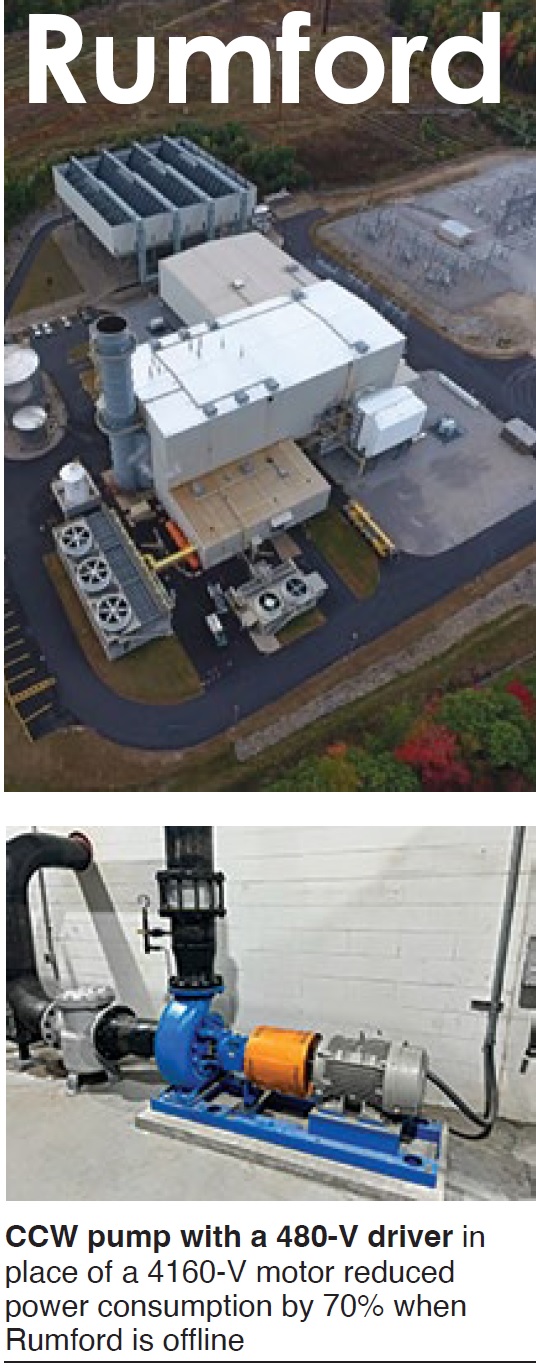Rumford Power LLC
Owned and operated by Cogentrix Energy Power Management
270 MW, gas-fired 1 × 1 7FA.03-powered combined cycle equipped with a Nooter Eriksen HRSG and a GE A10 steam turbine, located in Rumford, Me
Plant manager: Justin Castagna
 Reduce O&M cost by cutting energy consumption when offline
Reduce O&M cost by cutting energy consumption when offline
Challenge. The operational profile for Rumford Power has changed significantly over the past 20 years, as it has for many powerplants. Rumford now spends more time offline than online and consumes a large amount of station service energy to keep the plant available to the ISO.
Personnel collaborated to find ways to reduce station service load when offline. Two promising ideas emerged: Use a smaller air compressor and smaller closed cooling water (CCW) pump to satisfy offline needs. The original CCW pump, designed for baseload operation, has a 4160-V motor; the proposed offline CCW pump, a 480-V motor.
Solution. Reduce the power bill by identifying efficiencies that could be gained plantwide and execute promising projects. Two systems targeted were the plant compressed-air and CCW systems. Both were oversized for the service required when the plant was not operating.
Looking first at plant air, calculations based on metered readings were made to determine the cost of running the existing compressors when the plant was not producing electricity. Seeing an opportunity for savings, staff investigated lower-capacity, more-efficient compressors to fulfill plant needs while it was offline.
Staff also saw the large power draw from the 4160-V CCW motor could be reduced by installing a smaller pump for offline use.
Results. Both projects were successful. The new, quieter, more-efficient, and lower-capacity 480-V air compressor for offline use reduced power consumption for compression by 20%. Payback on this portion of the project was originally calculated at just under five years.
The CCW mod proved even more beneficial. Use of the 480-V drive assembly while the plant is offline reduced power consumption by over 70%, resulting in an estimated payback of less than two years (photo).
Given today’s astronomical power prices in New England, both projects are expected to pay for themselves in less time than originally predicted.
Project participants:
Bill Calden, Jon Hambrick, and Justin Henry
Faster hot starts benefit the bottom line
Challenge. Rumford Power had had a two-hour starting window with ISO-NE (New England) since beginning commercial operation 20 years ago. Previous guidance recommended holding the loading of equipment when stress curves hit 60%, as calculated by data monitoring software. Goal was to decrease the time required to release Rumford for dispatch during hot starts. Investments in gas-valve upgrades to obtain purge credits were not economically feasible.
Management decided to spend 2021 optimizing the performance of the dedicated operations team to reduce the time it took to go from first breaker close to the low economic operational limit of the plant.
Challenges to achieving the stated goal included the addition of four new operators to staff, and changing the accepted method of starting the plant. Operators historically had used the two-hour starting window to thoroughly check plant equipment and confirm its operation, performance, and setpoints. The push to consistently load the units to release the plant for dispatch faster and not spend as much time checking BOP equipment was an added stress to staff.
Baselines were established from the first four hot starts of the year: It took an average of 87 minutes to dispatch Rumford’s single unit, burning an average of just over 1500 dekatherms of natural gas.
Solution was to collaborate, share best practices, and optimize performance. The plant has a solid starting procedure, one modified over time to increase availability. Lessons learned have contributed to procedural adjustments to add checks and balances that ensure safe, reliable operation. By paying attention to detail, and communicating best practices from shift to shift regarding ways of reducing start time, the plant ultimately was able to eliminate hold points in the procedure and drive down startup costs.
Results. Over a period of 64 hot starts since the drive to increase starting efficiency began, the plant average for a start was less than one hour from first breaker close to release of the unit for dispatch with ISO-NE—a reduction of almost half an hour from previous averages. The plant also saw an average reduction in gas consumption of 485 Dth per start.
Given the volatile gas pricing in the New England market, this strategic operation performed by plant staff over the course of the year provided savings well into six figures for natural gas burned while bringing the plant online. The best result: There were no missed unit starts or trips attributed to this initiative.
Project participants:
Dean Baker, Trevor Boutaugh, Jesse Hilton, Bob Richardson, Nick Gray, Bill Calden, and B J Dunlap









